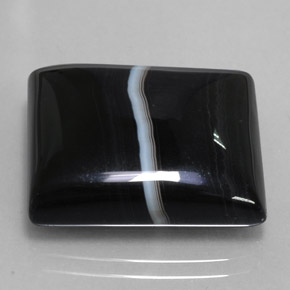What is Onyx?
Onyx is a banded variety of the oxide mineral chalcedony. Agate and onyx are both varieties of layered chalcedony that differ only in the form of the bands: agate has curved bands and onyx has parallel bands. The colours of its bands range from white to almost every colour (save some shades, such as purple or blue). Commonly, specimens of onyx contain bands of black and/or white.
Onyx is a gemstone whose description can have several connotations. Its most accepted gemstone definition describes a solid black Chalcedony, or a banded or layered black and white Chalcedony. The term Onyx is occasionally used to described any engraved stone with a solid colour base, or it may describe any banded gemstone with parallel banding. In its solid black form, Onyx is the most traditional black gemstone.
History and Introduction
Onyx is black and white banded agate (cryptocrystalline or chalcedony quartz). It should not to be confused with onyx marble, which is limestone. The banding of onyx is parallel and consistent. Some varieties of onyx differ in colour, such as sard onyx, which has a brown base and white upper layer, cornelian onyx, which has a red base and white upper layer, and niccolo onyx, which has a very thin upper layer, allowing the black base colour to show through as grey or blue. Onyx takes its name from the Greek word "onux", which means fingernail; this could be due to a Greek legend, in which Eros mischievously cut the fingernails of Aphrodite with an arrowhead whilst she slept, and the gods turned the clippings into stone. Onyx was cut and carved as a gemstone by the Ancient Greeks and Romans in cameos. Intaglio etchings (negative relief engravings) were also made from onyx. These carvings showcase the banding of onyx.
Imitations and treatments
The name has sometimes been used, incorrectly, to label other banded lapidary materials, such as banded calcite found in Mexico, Pakistan, and other places, and often carved, polished and sold. This material is much softer than true onyx, and much more readily available. The majority of carved items sold as "onyx" today are this carbonate material.
Artificial onyx types have also been produced from common chalcedony and plain agates. The first-century naturalist Pliny the Elder described these techniques being used in Roman times. Treatments for producing black and other colours include soaking or boiling chalcedony in sugar solutions, then treating with sulphuric or hydrochloric acid to carbonize sugars which had been absorbed into the top layers of the stone. These techniques are still used, as well as other dyeing treatments, and most so-called "black onyx" sold is artificially treated. In addition to dye treatments, heating and treatment with nitric acid have been used to lighten or eliminate undesirable colours.
Onyx: Origin and Gemstone Sources
Onyx deposits are found in countries all over the world, including Argentina, Australia, Brazil, India, Botswana, Madagascar, Mexico, Myanmar (Burma), Pakistan, Sri Lanka, Uruguay and the USA.
Identifying Onyx
Onyx can be identified by its black base and white upper layer with parallel banding. However, in the case of sard onyx the base is brown and cornelian onyx has a red base. It is difficult to identify when the material is a single colour and can only be clearly distinguished from agate when seen in the rough, exhibiting visibly parallel and consistent banding.
Historic uses
It has a long history of use for hardstone carving and jewellery, where it is usually cut as a cabochon or into beads. It has also been used for intaglio and hardstone cameo engraved gems, where the bands make the image contrast with the ground. Some onyx is natural but much of the material in commerce is produced by the staining of agate.
Onyx was used in Egypt as early as the Second Dynasty to make bowls and other pottery items. Use of sardonyx appears in the art of Minoan Crete, notably from the archaeological recoveries at Knossos.
Brazilian green onyx was often used as plinths for art decorative sculptures created in the 1920s and 1930s.
The German sculptor Ferdinand Preiss used Brazilian green onyx for the base on the majority of his chryselephantine sculptures. Green onyx was also used for trays and pin dishes produced mainly in Austria often with small bronze animals or figures attached.
Onyx is mentioned in the Bible many times. Sardonyx (onyx in which white layers alternate with sard) is mentioned in the Bible as well.
Onyx was known to the Ancient Greeks and Romans. The first-century naturalist Pliny the Elder described both type of onyx and various artificial treatment techniques in his Naturalis Historia.
Slabs of onyx (from the Atlas Mountains) were famously used by Mies van der Rohe in Villa Tugendhat at Brno (completed 1930) to create a shimmering semi-translucent interior wall.
The Hôtel de la Païva in Paris is noted for its yellow onyx décor, and the new Mariinsky Theatre Second Stage in Moscow uses yellow onyx in the lobby.
Properties of Onyx
| Chemical Formula | SiO2 |
| Colour | White, Black, Banded |
| Hardness | 7 |
| Crystal System | Hexagonal |
| Refractive Index | 1.54 - 1.55 |
| SG | 2.63 - 2.65 |
| Transparency | Translucent to opaque |
| Double Refraction | .009 |
| Luster | Vitreous |
| Cleavage | Indiscernible |
| Mineral Class | Quartz (Chalcedony) |






